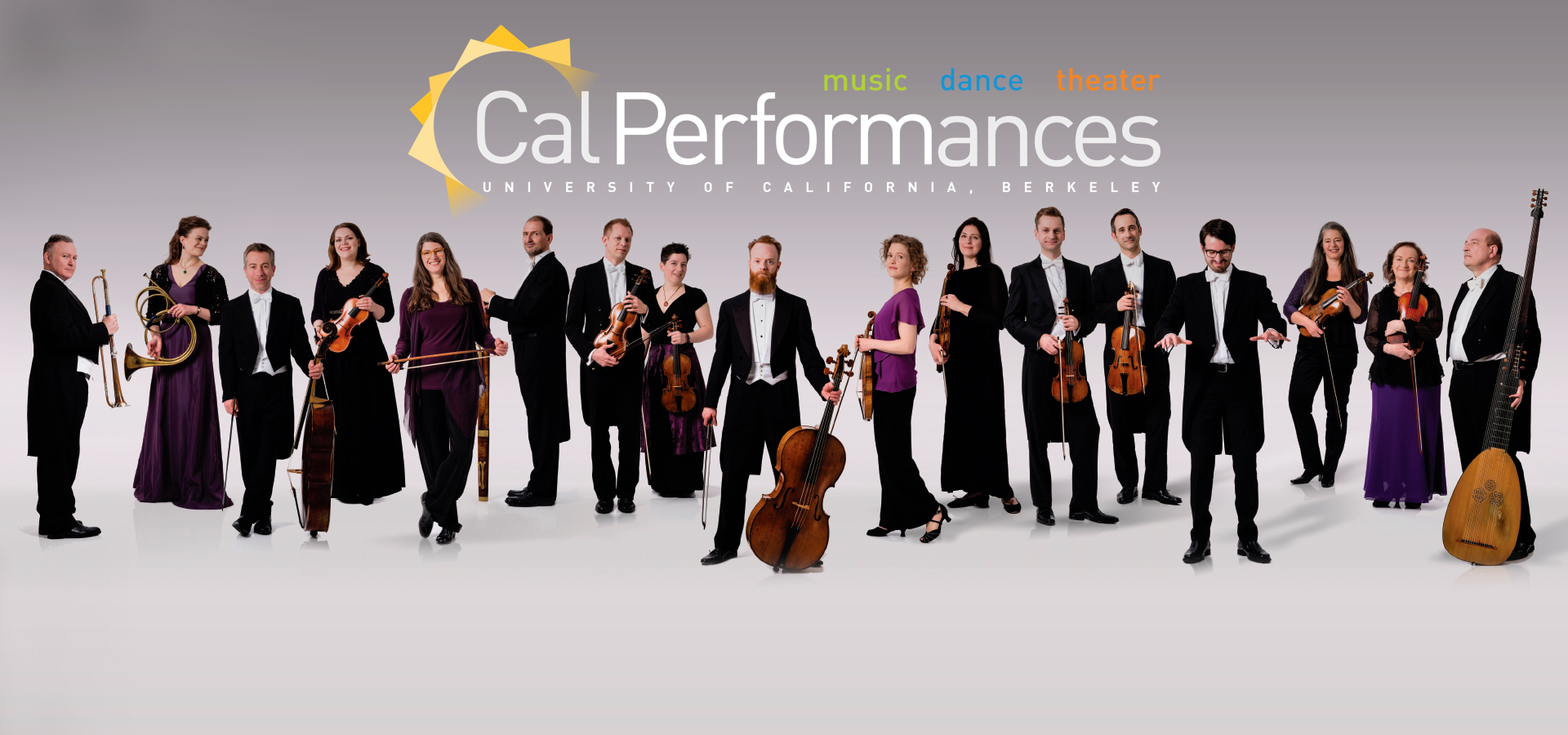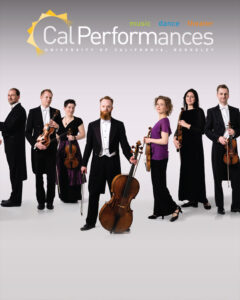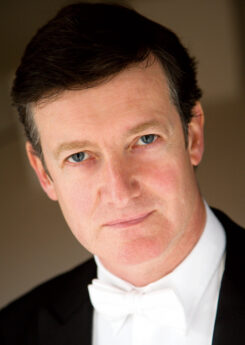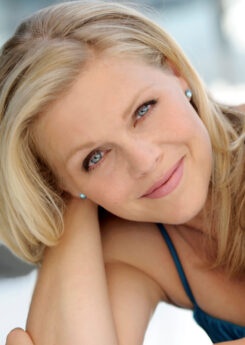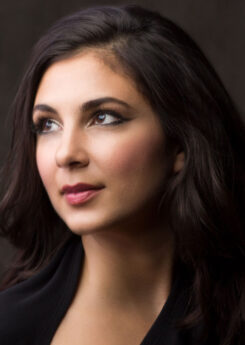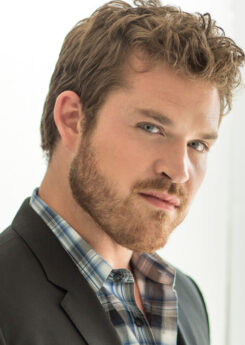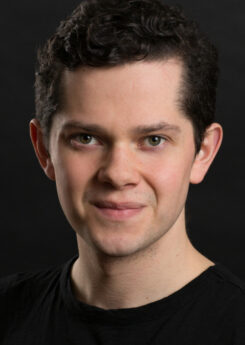The English Concert
Harry Bicket, artistic director, conductor, and harpsichord
Sunday, March 5, 2023, 3pm
Zellerbach Hall
This performance will include two 20-minute intermissions, the first following Act I and the second following Act II.
The performance will last approximately three hours and 10 minutes, including the two intermissions.
This performance is made possible, in part, by Bernice Greene, The Estate of Ross E. Armstrong, and an anonymous Patron Sponsor.
From the Executive and Artistic Director

It would be hard to exaggerate the depth and breadth of Cal Performances’ programming this month, a schedule distinguished by the culmination of our season-long, campus-wide residency honoring the visionary work of South African artist William Kentridge—the man the UK’s Guardian described as “continuously original, deeply humane, and vividly thought-provoking…one of the great artists of our time.” Residency events include the US premiere of Kentridge’s musical and theatrical work SIBYL at Zellerbach Hall (for more, see Thomas May’s excellent article, beginning on the next page), including a special gala honoring the artist; a presentation of the Dadaist poem Ursonate, performed by Kentridge himself; a staging of A Guided Tour of the Exhibition: For Soprano and Handbag, a bold and innovative work created by Kentridge and Joanna Dudley (who will also perform it); a retrospective of Kentridge’s films; the visual lecture To What End; and classroom conversations. We’re thrilled to play a major role in this extraordinary artistic endeavor and thank our partners—the Berkeley Art Museum and Pacific Film Archive (BAMPFA) and the Townsend Center for the Humanities—for their contributions to this great celebration.
During any other month, the Kentridge Residency would be more than enough to trumpet. But March at Cal Performances will also see a return engagement by the storied Vienna Philharmonic Orchestra, under conductor Christian Thielemann (making his Bay Area concert debut). Over the course of three programs at Zellerbach Hall, the orchestra will traverse a century of canonic repertoire—from the heroic music of Viennese classicism, through several generations of opulent Austro-German Romanticism, to the expanded sonorities of the Second Viennese School near the turn of the 20th century. These works showcase the mighty Vienna musicians at their finest, artists renowned for playing both “rich in detail and fearsome in its intensity” (The Guardian).
If all of this weren’t enough, we’ll also see a long-anticipated visit by New Orleans’ legendary Preservation Hall Jazz Band celebrating its 60th anniversary this year with a rousing program of traditional jazz, gutbucket funk, Afro-Cuban rhythms, folk, and pop; and a performance of Handel’s great oratorio Solomon (1748) with the renowned English Concert, the Clarion Choir, and an impressive array of guest vocalists. Our great friend Zakir Hussain returns with his ever-popular Masters of Percussion; the London-based Castalian Quartet makes its Cal Performances debut with a program that ranges from Haydn to Schubert to a haunting 2006 work by contemporary Finnish composer Kaija Saariaho; and we’ll cap off the month with concerts by the international all-woman jazz supergroup Artemis and the accomplished Zurich Chamber Orchestra with music director and violinist Daniel Hope.
Upcoming Illuminations: “Human and Machine” programming (much of it presented in conjunction with the Kentridge Residency) will continue to take advantage of Cal Performances’ unique positioning as a vital part of the world’s top-ranked public university. As we’ve done all
season long, we’ll be engaging communities on and off campus to examine the evolution of tools such as musical instruments and electronics, the complex relationships between the creators and users of technology, the possibilities enabled by technology’s impact on the creative process, and questions raised by the growing role of artificial intelligence in our society.
Please make sure to check out our brochures and our website for complete information about upcoming events. And stay tuned in April, when we announce our 2023–24 season; we’ve got plenty of exciting news for you.
Thank you for joining us at Cal Performances!
Jeremy Geffen
Executive and Artistic Director, Cal Performances
 It would be hard to exaggerate the depth and breadth of Cal Performances’ programming this month, a schedule distinguished by the culmination of our season-long, campus-wide residency honoring the visionary work of South African artist William Kentridge—the man the UK’s Guardian described as “continuously original, deeply humane, and vividly thought-provoking…one of the great artists of our time.” Residency events include the US premiere of Kentridge’s musical and theatrical work SIBYL at Zellerbach Hall (for more, see Thomas May’s excellent article, beginning on the next page), including a special gala honoring the artist; a presentation of the Dadaist poem Ursonate, performed by Kentridge himself; a staging of A Guided Tour of the Exhibition: For Soprano and Handbag, a bold and innovative work created by Kentridge and Joanna Dudley (who will also perform it); a retrospective of Kentridge’s films; the visual lecture To What End; and classroom conversations. We’re thrilled to play a major role in this extraordinary artistic endeavor and thank our partners—the Berkeley Art Museum and Pacific Film Archive (BAMPFA) and the Townsend Center for the Humanities—for their contributions to this great celebration.
It would be hard to exaggerate the depth and breadth of Cal Performances’ programming this month, a schedule distinguished by the culmination of our season-long, campus-wide residency honoring the visionary work of South African artist William Kentridge—the man the UK’s Guardian described as “continuously original, deeply humane, and vividly thought-provoking…one of the great artists of our time.” Residency events include the US premiere of Kentridge’s musical and theatrical work SIBYL at Zellerbach Hall (for more, see Thomas May’s excellent article, beginning on the next page), including a special gala honoring the artist; a presentation of the Dadaist poem Ursonate, performed by Kentridge himself; a staging of A Guided Tour of the Exhibition: For Soprano and Handbag, a bold and innovative work created by Kentridge and Joanna Dudley (who will also perform it); a retrospective of Kentridge’s films; the visual lecture To What End; and classroom conversations. We’re thrilled to play a major role in this extraordinary artistic endeavor and thank our partners—the Berkeley Art Museum and Pacific Film Archive (BAMPFA) and the Townsend Center for the Humanities—for their contributions to this great celebration.
During any other month, the Kentridge Residency would be more than enough to trumpet. But March at Cal Performances will also see a return engagement by the storied Vienna Philharmonic Orchestra, under conductor Christian Thielemann (making his Bay Area concert debut). Over the course of three programs at Zellerbach Hall, the orchestra will traverse a century of canonic repertoire—from the heroic music of Viennese classicism, through several generations of opulent Austro-German Romanticism, to the expanded sonorities of the Second Viennese School near the turn of the 20th century. These works showcase the mighty Vienna musicians at their finest, artists renowned for playing both “rich in detail and fearsome in its intensity” (The Guardian).
If all of this weren’t enough, we’ll also see a long-anticipated visit by New Orleans’ legendary Preservation Hall Jazz Band celebrating its 60th anniversary this year with a rousing program of traditional jazz, gutbucket funk, Afro-Cuban rhythms, folk, and pop; and a performance of Handel’s great oratorio Solomon (1748) with the renowned English Concert, the Clarion Choir, and an impressive array of guest vocalists. Our great friend Zakir Hussain returns with his ever-popular Masters of Percussion; the London-based Castalian Quartet makes its Cal Performances debut with a program that ranges from Haydn to Schubert to a haunting 2006 work by contemporary Finnish composer Kaija Saariaho; and we’ll cap off the month with concerts by the international all-woman jazz supergroup Artemis and the accomplished Zurich Chamber Orchestra with music director and violinist Daniel Hope.
Upcoming Illuminations: “Human and Machine” programming (much of it presented in conjunction with the Kentridge Residency) will continue to take advantage of Cal Performances’ unique positioning as a vital part of the world’s top-ranked public university. As we’ve done all
season long, we’ll be engaging communities on and off campus to examine the evolution of tools such as musical instruments and electronics, the complex relationships between the creators and users of technology, the possibilities enabled by technology’s impact on the creative process, and questions raised by the growing role of artificial intelligence in our society.
Please make sure to check out our brochures and our website for complete information about upcoming events. And stay tuned in April, when we announce our 2023–24 season; we’ve got plenty of exciting news for you.
Thank you for joining us at Cal Performances!
Jeremy Geffen
Executive and Artistic Director, Cal Performances
About the Performance
Despite his advancing years, 1749 was one of the greatest periods of George Frideric Handel’s career. Though he was now turning 64, his physical and creative vigor remained extraordinary even for a much younger man. He still maintained a relentless schedule each year of creating a pair of oratorios for the next Lenten concert season, as well as numerous other works, often commissioned by members of the royal family. As well as his new creative work, he revived earlier oratorios—in 1749 they were Samson, Hercules, and Messiah—which often required extensive revisions to accommodate new singers. He oversaw these productions, new and old, while also enriching them with his organ virtuosity.
Written during the spring and summer of 1748, Handel’s new oratorios for 1749 were a contrasting pair. Drawn from the Biblical apocrypha, Susanna was an intimate drama about a beautiful woman falsely accused by lecherous elders of the community. Premiered on March 17, 1749 at London’s Covent Garden Theatre, Solomon was its opposite: a spectacular, pageant-like oratorio about Israel’s greatest king based on the Old Testament Books of First Kings and Second Chronicles. As conductor John Eliot Gardiner wrote: “To my mind, Solomon is probably the most magnificent, certainly the most lavish of all the Handel oratorios. He demanded a grander, more sumptuous orchestra for Solomon than any earlier oratorio, and it contains a high proportion of choral music written in his most imposing ceremonial style.”
Why did Handel choose this subject at this particular time? Renowned for his wisdom, Solomon had built the great temple at Jerusalem and then presided over Israel’s longest period of peace and prosperity. But Handel was not musing solely about Solomon in 1748–49, he was also thinking about his own king and patron, George II. For many years, Europe had been roiled by the War of the Austrian Succession, which was now about to be concluded in the Treaty of Aix-la-Chapelle. It was a time for celebration, culminating on April 27, 1749—a month after Solomon’s debut—with an elaborate outdoor performance of Handel’s new Music for the Royal Fireworks. Both Solomon and the Royal Fireworks shared a common emphasis on musical splendor as well as a mood of optimism for the future.
So ancient Israel’s Solomon is here regarded as a model for George II, who was also leading England through a period of wealth and security. “What gives the oratorio its strength is Handel’s vision of Solomon’s court as an ideal society,” writes Handel scholar Winton Dean. Solomon’s librettist is unknown, but he was most careful to show Israel’s king as being without flaw—there’s no hint of Solomon’s harem of hundreds of concubines, for example. Writes Paul Henry Lang, the librettist “omitted all adverse nuances, making the King of the Israelites not only a paragon of monogamy but an irreproachable figure that could not have displeased the King of the English, who knew well that he and his subjects were beholding their own portrait.”
MUSICAL BOUNTY
An enlarged chorus—big enough for Handel to frequently divide into double choruses—is the undisputed star of Solomon. Dean: “The choruses of Solomon are among the greatest Handel ever wrote, and they illustrate the remarkable range and flexibility of his technique.” There are choruses, like the antiphonal double chorus “Your Harps and Cymbals Sound” opening Part I and the oratorio’s closing number “Praise the Lord with Harp and Tongue,” that epitomize Baroque ceremonial splendor. But there are also more intimate moments like the beautiful “May no rash intruder” (also known as the “Nightingale Chorus”) that accompanies Solomon and his Queen to bed at the end of Act I.
A large chorus requires the support of a large orchestra. And Handel was able to assemble his most lavish instrumental ensemble for this oratorio, including flutes, oboes, bassoons, horns, trumpets, strings, and continuo. The expanded string section allowed him to divide both violins and violas into two parts, providing richer, weightier harmonies.
With the prominence of the chorus, Handel reduced his customary emphasis on solo singers displaying their virtuosity in elaborate da capo arias. Though there are some lovely arias scattered throughout the score, they are often simpler in style and omit da capo repeats. More striking are Handel’s vocal ensembles, including the love duet of Solomon and his Queen and a trio for Solomon’s famous judgment of the two women claiming the same child in Act II.
Interestingly, Handel chose to give the role of Solomon to a female mezzo soprano, Caterina Galli. Gardiner suggests why: “In this particular work Handel wanted to achieve a neutrality for the central character. To have had Solomon sung by a castrato wouldn’t have been quite right as castratos were generally associated with fictitious operatic heroes, often tyrants or thwarted lovers. George II wouldn’t perhaps have thanked him for that.” Thus the soloists skew toward female voices, with the tenor and bass consigned to lesser roles.
THE SCENARIO
Solomon is not conceived as a continuous dramatic plot but instead as a series of tableaux, each illustrating a particular aspect of Solomon’s greatness. In Part I, Solomon’s religious devotion is shown as he celebrates the consecration of the Temple in Jerusalem. The second half of this section demonstrates his fidelity in marriage to his young queen; Handel fills it with some of his most unabashedly sensuous music, including an ardent love duet and the gorgeous “Nightingale Chorus.” The most dramatic of the acts is Part II, which shows Solomon’s wisdom as he skillfully judges the case of the two competing women. Part III displays Solomon’s wealth and international stature as he hosts the Queen of Sheba visiting from the Arabian peninsula.
LISTENING TO THE MUSIC
Part I: Solomon opens with an overture in the French style, combining a slower ceremonial opening section with a quick-tempo Fugue of exceptional brilliance. The scene then opens on a crowd of Israelite citizens and priests assembled to consecrate Solomon’s Temple. The magnificent first double chorus “Ye harps and cymbals sound” is an extraordinary display of antiphonal counterpoint built from the basses’ unison singing of a majestically ascending phrase followed by a slower descending one. This forms a cantus firmus theme that keeps returning to anchor the dazzling back-and-forth calls of the two choruses.
After a pro forma aria for the basso Levite, an equally remarkable second chorus of the priests, “With pious heart and holy tongue,” opens with hushed homophonic singing in C minor over the orchestra’s solemn pulsing. This expression of awe and humility before God then explodes into a joyous antiphonal fugato. The many overlapping entries of the eight vocal parts thrillingly capture the feeling of an infinite number of voices and nations joining the song of praise.
Rather than a triumphant da capo aria, Solomon’s first utterance is a quiet prayer of thanksgiving to God, voiced in a subdued recitativo accompagnato over a beautifully expressive orchestral part. And when a little later, he finally sings his da capo “What though I trace each herb and flow’r,” it is equally modest, staying within the compass of an octave and foregoing any florid display. With its violins imitating sighing breezes, this aria is the first of many numbers that extoll Nature’s beauty and power. Such poetic imagery always inspired Handel’s best.
The subject now changes from corporate worship of God to the intimate pleasures of a happy marriage. This second scene shows Solomon as devoted husband, besotted by the beauty of his Egyptian queen, and Handel explores this with music of exquisitely sensuous beauty for the two lovers. (In fact, public disapproval of such frank sexuality being introduced into an oratorio caused Handel to bowdlerize his score for later revivals!) The Queen introduces herself with “Bless’d the day,” a dancing da capo sparkling with youthfulness and joyous coloratura. This leads to an entrancing love duet, “Welcome as the dawn of day,” in which the orchestra’s double violin parts intertwine around each other in a graceful imitation of the loving pair’s closeness.
Part I closes with one of the greatest, though quietest, of the oratorio’s choruses, “May no rash intruder” (the “Nightingale Chorus”) scored for five voices and a superbly colorful orchestra. Again the sounds of Nature are invoked as divided violins and violas mimic the “soft-breathing zephyrs” and a pair of flutes conjure the song of the nightingales. Animated by syncopation, the choral parts are beautifully and subtly crafted. And thus an act that began with resounding splendor closes with a softly enchanting choral benediction.
PART II
Part II contains Solomon’s only scene of theatrical drama as the King adjudicates the case of the infant claimed by two harlots (Handel objected to calling them that). We hear the full orchestra for the first time as blazing trumpets and drums join the eight-voice double chorus in one of the oratorio’s mightiest numbers, “From the censor curling rise.” In this D-major hymn of praise to Solomon, Handel divides his chorus into two, singing antiphonally to each other in block chords. To differentiate the two groups, Handel chose trumpets, timpani, and strings to accompany Chorus I and woodwinds and horns for Chorus II. The opening and closing antiphonal sections enclose a full-dress fugue, “Live, live forever, pious David’s son.”
The two women are ushered in to plead their cause. A remarkable trio in the troubled key of F-sharp minor, “Words are weak to paint my fears,” is launched by the first woman. Bolstered by the orchestra and its wailing high violins, her anxious phrases are halting, riddled with pauses. Eventually, the second woman grows impatient and leaps in, harshly declaring the other is false. Beneath them, Solomon’s lines remain measured and calm. Such ensembles featuring multiple characters, each individually drawn, were a rarity in Handel’s aria-dominated time. Solomon dispassionately commands the baby be cleaved in two and half given to each woman. In a pompous aria, the second woman praises the King’s wisdom and happily accepts his decree. The first woman’s response, however, is voiced in a heartbreaking aria in F minor, “Can I see my infant gor’d,” intensified by the orchestra’s biting dissonances. She cannot bear to see her child killed and therefore begs the other to “take him all.” Solomon has flushed out the real mother.
Recalling Part’s II’s opening chorus, trumpets and timpani return for the resplendent “Swell, swell, the full chorus,” which closes and frames the act. Here singing in four parts to a strongly accented triple meter, the Israelites praise Solomon’s wisdom and his worthiness to be their king. Between their mighty homophonic utterances, the texture becomes open and contrapuntal with choral melismas adding to the joy.
PART III
From intimate drama we now return to pageantry. The final act opens with Solomon’s most famous excerpt, the sparkling orchestral sinfonia that announces “The Arrival of the Queen of Sheba,” who has traveled from distant Arabia to behold the wonders of Solomon’s kingdom. Here Handel exploits the contrasting colors of his well-stocked ensemble with racing strings juxtaposed against pungent oboes.
The musical highlight of Part III is a Purcell-influenced masque of four choruses demonstrating how effectively music can portray drastically different scenes and emotions. This is an entertainment conceived by Solomon to delight the Queen of Sheba, and he acts as master of ceremonies briefly introducing each piece. The hushed first chorus in G major gracefully illustrates its words, “Music, spread thy voice around/Sweetly flow the lulling sound,” with floating lines caressed by delicate ornaments. Next, galloping dotted rhythms carry us onto a D-major battlefield, as the chorus divides into two four-voice groups hurling their weapons against each other (“Shake the Dome”); martial trumpets urge them on.
Solomon interrupts this stunning number before it finishes to summon up the spirit of melancholy and love’s torments with the impressive “Draw the tear from hopeless love.” In this dark G-minor chorus in Largo tempo, Handel uses dissonance skillfully to paint his text. The textural shifts from lovely, open counterpoint among the five voices to homophonic cries of despair are wonderfully chosen. Moving to warm E-flat major and partnered by a cello, Solomon then launches the final chorus, “Thus rolling surges rise,” and restores calm to the troubled emotional seas. With flowing melismas mimicking the rolling waves, Handel shows that music with clear diatonic harmonies and no disturbances need not be boring.
Among the arias that follow this great sequence, one stands out: the Queen of Sheba’s beautiful farewell aria “Will the sun forget to streak” as she prepares to leave Solomon. Rather than being in a conventionally happy tempo and a bright major key, this is a valedictory song in E minor and Largo tempo that encompasses both wonder and regret at having to leave Solomon’s blessed realm. Keening oboes are ideal accompanying soloists.
The final chorus that closes Solomon is somewhat in dispute. While most editions place the rather pedestrian “The name of the wicked shall quickly be past” at the end, many conductors are choosing instead to replace it with the penultimate—and much greater—eight-voice double chorus in D major “Praise the Lord with harp and tongue.” Paired with a spectacular full-orchestra part, this chorus begins quite modestly with a single choir, then grows in splendor as the second choir is introduced and the two hurl their exclamations of praise back and forth. The orchestra, too, progressively becomes more sumptuous as various instruments—and most of all the trumpets and timpani—are brought into the foreground. Another of Handel’s choral masterpieces, “Praise the Lord” rises to the majesty of the two choruses with which Solomon began three hours earlier.
—Janet E. Bedell
© 2023 Carnegie Hall.
Reprinted with permission.


